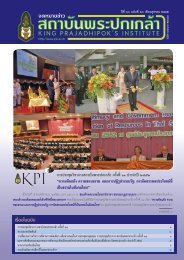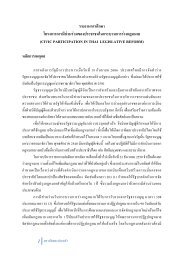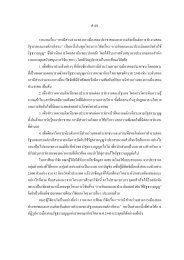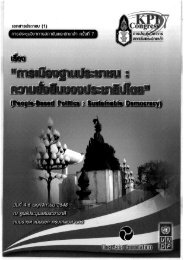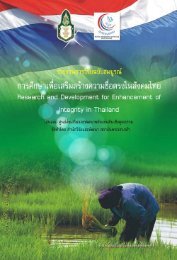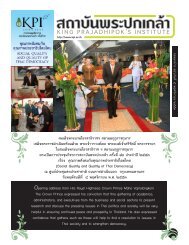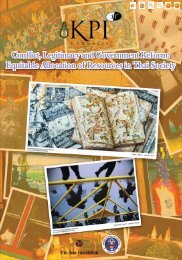SUFFiciENcy EcONOMy ANd GRASSROOtS DEvElOPMENt
SUFFiciENcy EcONOMy ANd GRASSROOtS DEvElOPMENt
SUFFiciENcy EcONOMy ANd GRASSROOtS DEvElOPMENt
You also want an ePaper? Increase the reach of your titles
YUMPU automatically turns print PDFs into web optimized ePapers that Google loves.
The Meaning of Sufficiency Economy <br />
International Conference<br />
185<br />
benefits to the whole community (not just those involved in the immediate<br />
transaction); and 3) it focuses on concrete use value and the limited accumulation<br />
thereof, rather than on abstract exchange value and its impetus toward unlimited<br />
accumulation (139). For Daly and Cobb, community is sorely missing in Western<br />
conceptions of the economy as well as in the lives of people in the modern world.<br />
For economic anthropologist Stephen Gudeman, the community economy is<br />
right there before our eyes. Gudeman has theorized community economy as an everpresent<br />
economic realm existing in dialectic relation with the market realm: these<br />
may at times be separate or overlapping, complimentary or in tension, and we may<br />
sometimes emphasize one over the other or participate in these realms for different<br />
purposes. Where the market is abstract and impersonal, characterized by<br />
anonymous, short-term exchanges, the communal realm is local and specific,<br />
constituted by social relationships and contextually defined values. At a time when<br />
“the economy” has become synonymous with “the market,” Gudeman’s detailed<br />
exposition of the communal realm is a much needed reminder that real economies<br />
are much more diverse and varied and above all center on people.<br />
The core concept in Gudeman’s community economy model is the commons<br />
or base, a community’s shared interests such as physical resources and produced<br />
things that help sustain the members’ individual and collective livelihoods. The most<br />
common definition of a commons stops here, yet it also encompasses “ideational<br />
constructs such as knowledge, technology, laws, practices, skills, and customs” (7)<br />
as well as the cultural agreements and beliefs that shape or assign values to social<br />
relationships, transactions of goods and services, and accumulated wealth. The<br />
instrumental act of contributing to the base reproduces the group materially while at<br />
the same time reinforces commitment and identity as a community member; or more<br />
simply put: “the base makes the community as it is made” (36). According to<br />
Gudeman, the central acts in a community economy are creating, maintaining, and<br />
sharing the base, as opposed to market capitalism, where the focus is making and<br />
accumulating profits.<br />
Making and maintaining the base relies heavily on situated reason. Situated<br />
reason refers to knowledge that is produced through trial and error or innovation on<br />
the ground, which allows flexibility to find the most appropriate solutions and treats<br />
all individuals as potential agents. It is what Stephen Marglin (1990) terms techne<br />
(tactile practical knowledge), as opposed to episteme (abstract analytic knowledge),<br />
the latter of which is privileged in Western culture and dominates mainstream<br />
development activities. Beyond what is gleaned through tinkering, situated reason<br />
may also draw on a dynamic array of beliefs, values, and practices that encompass<br />
familiarity with the immediate environment; spiritual ideas about the relationship<br />
between humans, nature, and the supernatural; cultural practices of resource<br />
management and dispute resolution; and so on—the ideational constructs that make<br />
up part of the base itself. Finally, situated reason may be viewed as contextually<br />
dependent rationality. Take for example a woman on her way to market who refuses<br />
to sell her heavy load to a foreigner offering more than market value; she may be



